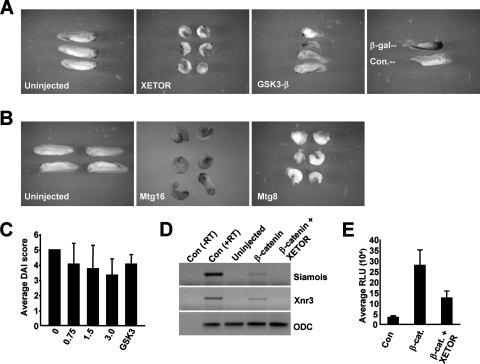FIG. 6.
XETOR affects axis formation in Xenopus embryos. (A) Microinjection of XETOR ventralizes Xenopus embryos. Injection of XETOR RNA into the marginal zones of both dorsal blastomeres at the 4-cell stage (3 ng each) resulted in 92% (123/133; six independent experiments) of the embryos having a ventralized phenotype compared to uninjected sibling controls (left panel). As a positive control, injection of GSK-3β RNA (500 pg each) into the marginal zones of both dorsal blastomeres at the 4-cell stage also resulted in embryos having a ventralized phenotype (82%; 14/17). Embryos were injected with mRNA encoding β-galactosidase (β-Gal) as an injection control. An embryo stained for β-Gal is shown above an uninjected embryo for comparison. (B) Mammalian Mtg16 and MTG8 act similarly to XETOR. Microinjection of 3 ng of mRNA encoding Mtg16 (75%; 12/16 embryos) or MTG8 (61%; 37/60 embryos; four independent experiments) into the marginal zones of both dorsal blastomeres at the 4-cell stage ventralized the embryos as in the experiment for which results are shown in panel A, in contrast to uninjected sibling controls (left panel). (C) Xenopus embryos at the 2- to 4-cell stage were injected with increasing amounts of XETOR mRNA, as indicated, in both dorsal blastomeres, and DAI scores were determined. GSK3β was included as a positive control. The numbers below the graph indicate the amount of mRNA injected (in nanograms). (D) XETOR impairs β-catenin-dependent transactivation in vivo. Embryos at the 2-cell stage were either mock injected, injected with β-catenin alone, or coinjected with mRNAs encoding β-catenin and XETOR, and the levels of the Wnt target genes Siamois and Xnr3 were determined by RT-PCR analysis of the animal caps. Con (−RT), PCR lacking reverse transcriptase, used as a PCR control; Con (+RT), positive control for the PCR. (E) In vivo analysis of TCF-dependent transcription. The TOP-FLASH reporter plasmid was coinjected with mRNA encoding the indicated transcription factors. Luciferase activity was determined, in triplicate, from lysates made from pooled embryos (typically 5 embryos). β-cat., β-catenin. Results of one representative experiment out of four performed are shown.

